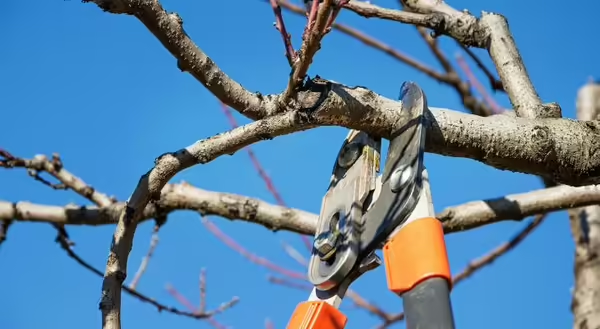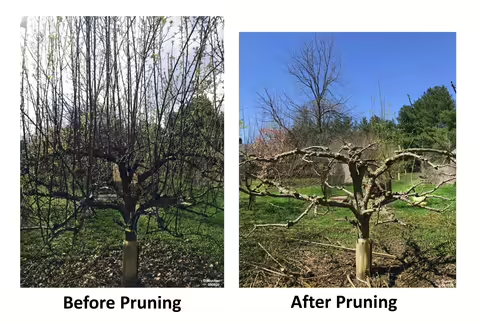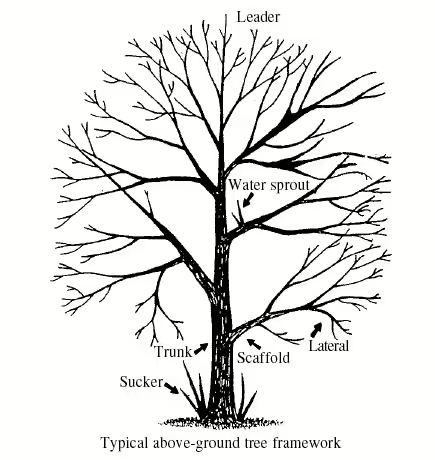
One of the secrets to getting fruit out of your home orchard year after year is annual pruning during the dormant season. This early-spring task can increase fruit quality, reduce the occurrence of diseases, and improve tree health in the long term, but many people are nervous about pruning or too heavy-handed with the clippers.
Why should you prune fruit trees?
The goal is to balance tree and fruit growth. Shaping young trees will keep them strong as they grow, and removing extra vegetation has the added bonus of keeping trees in home orchards smaller and easier to manage.
When to prune?
The best time to prune is before the sap starts to flow and foliage obstructs your view but after the worst of winter. This is called “dormant pruning,” and for Central Illinois that can be as early as mid-February.
What should I prune?
The easiest branches to remove will be the water sprouts. Water sprouts grow vertically from horizontally trained scaffold branches – the tree’s main limbs. Water sprouts do not contribute to fruit production and limit sunlight, and fruit production, in the canopy. Once the water sprouts are gone, additional pruning and shaping is easier.
How should I shape the tree?
Before you get scissor-happy, take a peek at your tree’s main limbs. You might need to use branch spreaders to gently nudge old and new scaffold branches in the right direction.
Branch spreaders are traditionally made from a hard wire with a diagonal cut at each end or from linear pieces of wood with a nail in each end, with the nail head cut off similarly as the wire. In both cases, a variety of lengths will accommodate the different sizes of branches in the canopy. In a backyard setting with only a few trees, you can use soft rope or twine to pull scaffold branches into place before staking them in the ground beneath the tree. The rope can be adjusted as needed throughout the growing season. If you need to make a new scaffold, use very small spreaders once a new young branch is 3 to 5 inches long.
What about insect management? Dormant sprays are applied in late winter or early spring to manage insect eggs and adult insects overwintering in the rough bark of older trees. Sprays smother the eggs and adults so thorough coverage is critical for good control. There are a variety of dormant oil sprays and they are considered organic.
Basic Do’s and Don’ts
- Do: Use sharp, clean tools; Cut a branch as close as possible to the tree; Remove diseased or broken branches.
- Don’t: Allow scaffold limbs to have a narrow crotch; Leave stubs; Treat cuts.
This Pruning the Home Orchard guide from New Mexico State University is a great reference for new and seasoned pruners for a variety of trees – apple, cherry, pear, plum and peach.
Looking for more? Illinois Extension has a lot of materials exploring a variety of pruning topics:
Pruning Blogs
- Berries and Brambles: Raspberry Management and Pruning
- Time to Prune Roses
- Dormant Shrub Pruning
- Have I Missed a Chance to Prune My Spring Shrubs?
Pruning Webinars
- Home Orchards
- Berries, Brambles and Beyond
- Grow Your own Backyard Tree Fruit
- Small Shrubs for the Landscape
- How to Kill Your Tree: A Guide of What NOT To Do
- Grape Vine Pruning
Source: Illinois Extension Educator Richard Hentschel
About the Blog
University of Illinois Extension is the original go-to source for growers, DIYers and jacks of all trades. For more than a century, Illinois Extension expert educators have shared university research in communities across the state. Get advice you can trust on horticulture, agriculture and nutrition in the Know How Know More blog. Build your best life. Trust Extension to help. Want to get notified when new posts are available? Sign up here!
Doug Gucker is a Local Food Systems and Small Farms educator with University of Illinois Extension in DeWitt, Macon and Piatt counties. He improves producer profitability and sustainability through demonstration and programming focused on using appropriate management strategies, soil health, nutrient management, integrated pest management, cover crops, beekeeping, grazing and urban farming.

